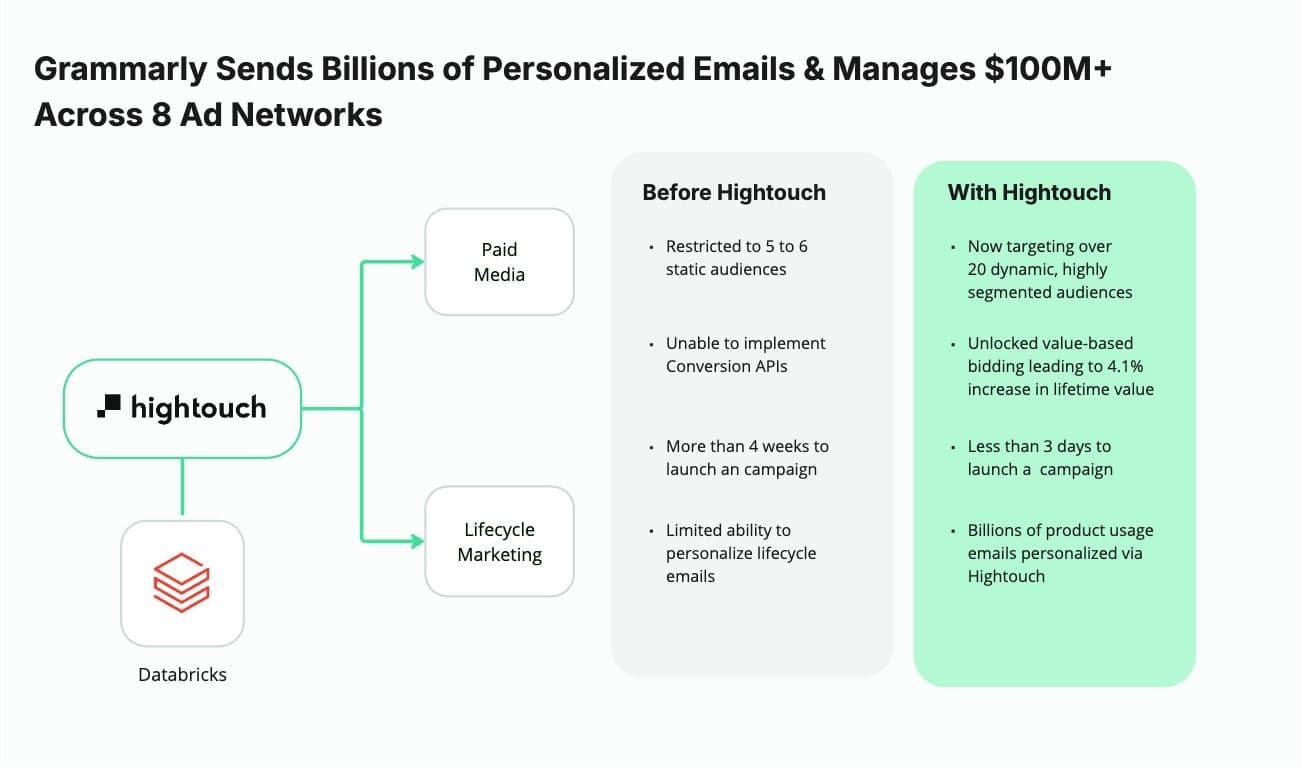
How Grammarly personalizes billions of emails & manages a 9-figure ad budget across 8 ad networks
Grammarly is the trusted AI assistant for communication and productivity, helping over 40 million people and 50,000 organizations do their best work. Companies like Atlassian, Databricks, and Zoom rely on Grammarly to brainstorm, compose, and enhance communication that moves work forward. Grammarly works where you work, integrating seamlessly with over 500,000 applications and websites.
Overview
The challenge: Grammarly has a complex and sophisticated marketing funnel. The company spends 9 figures every year on paid ads to acquire users and sends upwards of 5 billion emails annually to nurture, convert, and build loyalty with those users. The success of this funnel is predicated on personalization. However, fragmented customer data, a slow ticketing system, and manual CSVs limited new ad optimization strategies, making it challenging to launch personalized email campaigns in a timely and efficient manner.
The solution: Grammarly implemented Hightouch’s Composable CDP to support a significant portion of their paid media and email use cases. The entire marketing organization can now fully self-serve, which means they can launch more campaigns and more effectively personalize outreach to their customers.
The result: Grammarly powers a significant portion of paid media use cases and billions of product usage emails through Hightouch. The time it takes to launch and execute a batch-and-blast campaign has dropped from 4 weeks to 3 days, and the paid media team has jumped from targeting 5 to 6 static audiences to over 20 dynamic and highly segmented audiences. The paid media team also used Hightouch to implement new conversion API use cases for value bidding, improving lifetime value (LTV) by 4.1%.
“If we had to get rid of Hightouch, we’d riot. It underpins our entire marketing funnel and strategy. Marketing is all about personalization, and that’s what Hightouch gives us.”

Trevor Luescher
Marketing Systems Architecture at Grammarly
The challenge
Grammarly has 40M+ active users, made up of free, paying, and enterprise customers. The company’s self-serve business model is built around a sophisticated marketing funnel, which focuses on acquiring users through ads and converting them to paid subscribers through email. Converting users increases not just immediate revenue but expands each user’s LTV—which feeds back into their LTV-to-CAC optimization loop for paid media.
Having a product that anyone can use makes audience targeting and lifecycle orchestration very complicated because every user is unique (e.g., a student is much different than a customer at a B2B SaaS company or a small business owner). Personalization, at this scale, quickly becomes impossible without a flexible and scalable platform to support these use cases—and this was the exact problem Grammarly had run into. The marketing teams were unable to self-serve and build audiences, which meant the paid team was accidentally targeting existing users, and the lifecycle team couldn’t access the data points they needed to build and launch campaigns.
The evaluation
Grammarly’s existing data infrastructure is built on top of Databricks, where the data science team has invested in core data models around propensities, churn, LTV, and other custom objects. A traditional CDP simply couldn’t support this level of complexity across Grammarly’s B2B, B2C, and education markets. The only way to take advantage of all this data was to adopt a Composable CDP on top of Databricks.
The solution
Grammarly chose Hightouch because the platform integrated directly with all of their existing data infrastructure, which meant they could skip the long implementation time associated with traditional CDPs and start driving value immediately. Marketers are now self-serving and building audiences in Hightouch across marketing channels for core use cases. This self-serve motion means the team can not only build and launch more campaigns, but they have also unlocked additional use cases for both paid media and lifecycle.

The outcomes
Optimizing paid media & increasing ROAS
Grammarly’s entire marketing funnel is focused on acquiring new users and getting them into the lifecycle funnel. When you’re spending 9 figures on ads, optimizing spend is everything, so suppressing existing users from campaigns is critical. Before Hightouch, the paid team relied on manual CSV uploads to eight different ad platforms. This meant the audiences were often stale, existing users weren’t being suppressed, and targeting capabilities were extremely limited.
“Before Hightouch, we had a few core audience lists that we uploaded every month. Post Hightouch, we’ve increased our audiences by 3x, and we don’t have to deal with any more CSVs—Hightouch handles everything automatically, and the data just shows up in our ad platforms.”

Alexandra Chang
Display Marketing Manager at Grammarly
Another major advantage to Hightouch is that the paid team is now taking advantage of the conversion APIs the ad platforms offer, which means they can send over conversion events directly from Databricks with associated propensity values to better train the algorithm so they can reach more users who have a higher likelihood of converting. Since rolling out this new advertising strategy, the team has already seen a 4.1% lift in lifetime value for all new conversions through Google Search.
“The ability to push conversion data into our key ad platforms from Hightouch is game-changing. What used to take multiple months can now happen in a few weeks. We're now able to quickly train the ad platform algorithm on our predictive user models, and we’ve already seen a 4.1% lift in LTV.”

Alexandra Chang
Display Marketing Manager at Grammarly
Powering billions of emails
Email is core to Grammarly’s business and an important growth lever for the company because the entire lifecycle program is focused on converting freemium users, retaining existing users, and building loyalty. For Grammarly, an owned channel like an email maximizes the ROI of their existing acquisition spend because they no longer have to pay to reach those users through ad platforms.
The company sends billions of emails every year, but the most notable one is the weekly “insights” email. Every week, Grammarly sends out a personalized email to their users, showcasing individual stats and metrics that are personalized and specific to each individual user.

These emails make up nearly half of all the messages sent by the company. Grammarly uses Hightouch to send all of these critical product usage insights directly to Iterable to power these weekly campaigns. The calculations that power these emails are really sophisticated, which is why Grammarly builds them in Databricks first and relies on the Composable CDP to turn them into action. Additionally, the files that make up these data sets are massive, so Hightouch’s scale and speed are critical.
The company is also powering a number of other lifecycle use cases like:
- Payment reminders to reduce passive churn from payment failures
- Onboarding emails to introduce key features and encourage engagement
- Promotional offers to nudge freemium users toward paid plans
- Churn prevention to offer incentives to users who are at risk of churning
- Reactivation emails to win back churned users with incentives or promotions
“Our weekly insights emails are a critical part of Grammarly—they’re a big reason we have such a high retention rate. With Hightouch, we’re able to leverage all of the complex metrics we’ve calculated in Databricks to power millions of emails every week and billions every year.”

Trevor Luescher
Marketing Systems Architecture at Grammarly
What’s next?
Grammarly is continuing to expand Hightouch use cases to deliver even more relevant experiences to its users. The team is working to unify all of their different data models under one umbrella to eliminate inconsistencies so they can deliver an omnichannel experience across every touchpoint.
“With Hightouch, we’re able to centralize all of our data under one centralized schema to support the various marketing teams across the lifecycle, acquisition, and demand generation. This type of flexibility is simply not possible with a traditional CDP.”

Trevor Luescher
Marketing Systems Architecture at Grammarly